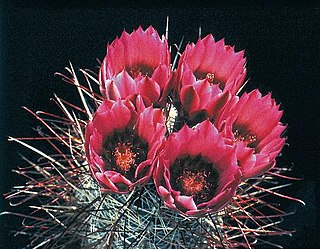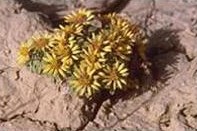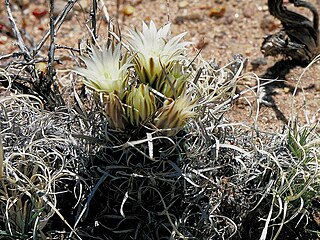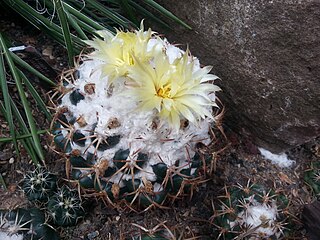
Pediocactus is a genus of cacti. The genus comprises between 6 and 11 species, depending upon the authority. Species of this genus are referred to as hedgehog cacti, though that name is also applied to plants from the genera Echinocereus and Echinopsis. Species may also be referred to as pincushion cacti, a common name which is also applied to other genera.

Sclerocactus is a genus of cacti. It comprises about 15 species, the exact number depending on the authority. These species are very xerophytic. They are sometimes called 'fishhook cactus' or 'little barrels.'

Pediocactus winkleri, commonly known as Winkler's cactus or Winkler's pincushion cactus, is a small cactus endemic to the state of Utah in the United States. It is known only from Emery and Wayne Counties.

Sclerocactus polyancistrus is a species of cactus known by several common names, including redspined fishhook cactus, Mojave fishhook cactus, pineapple cactus, and hermit cactus.

Escobaria robbinsorum is a rare species of cactus known by the common names Cochise pincushion cactus and Cochise foxtail cactus. It is native to southern Arizona in the United States, where it is known only from Cochise County, and northern Sonora in Mexico. There are scattered small occurrences on the north side of the border, and one known population to the south. Because of its rarity and a number of threats to remaining plants, the species was federally listed with a threatened status in 1986.

Echinomastus mariposensis is a rare species of cactus known by the common names Lloyd's fishhook cactus, golfball cactus, silver column cactus, and Mariposa cactus. It is native to a small section of territory straddling the border between Brewster County, Texas, in the United States and the state of Coahuila in Mexico. It has been federally listed as a threatened species in the United States since 1979.

Pediocactus bradyi is a very rare species of cactus known by the common names Brady's pincushion cactus, Brady's hedgehog cactus, and Marble Canyon cactus. It is endemic to Arizona in the USA, where it is restricted to Marble Canyon in Coconino County, though its exact distribution is not generally advertised due to poaching concerns. It is limited to a specific type of soil, it has a small distribution, and the species is threatened by a number of human activities. This has been a federally listed endangered species of the United States since 1979.

Pediocactus despainii is a rare species of cactus known by the common names Despain's cactus and San Rafael cactus. It is endemic to the state of Utah in the United States, where it is limited to the San Rafael Swell in Emery County, Utah.

Pediocactus knowltonii is a rare species of cactus known by the common names Knowlton's miniature cactus, Knowlton's pincushion cactus, and Knowlton's minute cactus. It is endemic to San Juan County, New Mexico, in the United States. It is the smallest and rarest species in genus Pediocactus. It is threatened by a number of human activities. It is federally listed as an endangered species of the United States.

Pediocactus peeblesianus is a rare species of cactus known by the common names Navajo pincushion cactus. It is endemic to the state of Arizona in the United States. One subspecies of the plant is federally listed as an endangered species of the U.S.

Sclerocactus brevispinus is a rare species of cactus known by the common name Pariette cactus. It is endemic to Utah in the United States, where it is known only from the Pariette Draw, a draw in Duchesne County. It is threatened by a number of processes and human activities.

Sclerocactus glaucus is a rare species of cactus known by the common name Colorado hookless cactus. It is endemic to Colorado in the United States, where it is known only from the area between Grand Junction and Montrose. It is a federally listed threatened species.

Sclerocactus wetlandicus is a rare species of cactus known by the common name Uinta Basin hookless cactus. It is endemic to Utah in the United States, where it is known only from the Uinta Basin. It may also be called the Pariette cactus, but this name is more appropriate for Sclerocactus brevispinus, the species endemic to the Pariette Draw of Duchesne County.

Sclerocactus wrightiae is a rare species of cactus known by the common names Wright's little barrel cactus and Wright's fishhook cactus.

Townsendia aprica is a rare species of flowering plant in the aster family known by the common name Last Chance Townsend daisy. It is endemic to Utah in the United States, where it is known from three counties. It faces a number of threats and it is a federally listed threatened species of the United States.

Sclerocactus papyracanthus is a species of cactus known by the common names paperspine fishhook cactus, grama grass cactus, paper-spined cactus, and toumeya. It is native to North America, where it occurs from Arizona to New Mexico to Texas and into Chihuahua, Northeastern Mexico.
Echinomastus erectocentrus is a species of cactus known by the common names redspine fishhook cactus, redspine butterfly cactus, acuña cactus, needle-spine pineapple cactus, red pineapple cactus, and purple-spine viznagita. It is native to Arizona and New Mexico in the United States and Sonora in Mexico.

Sclerocactus sileri, the Siler fishhook cactus, is a rare and very small cactus found mostly in mineral-rich desert areas of intermediate elevations, notably in the American states of Utah, Nevada, and northern Arizona.
Moneilema semipunctatum is a species of beetle in the family Cerambycidae. It was described by John Lawrence LeConte in 1852. It is known commonly as the cactus borer beetle. Beetles of genus Moneilema are known commonly as cactus longhorn beetles. It is native to North America, where it occurs in the western United States and Mexico.

Coryphantha pycnacantha is a cactus species endemic to central Mexico.



















